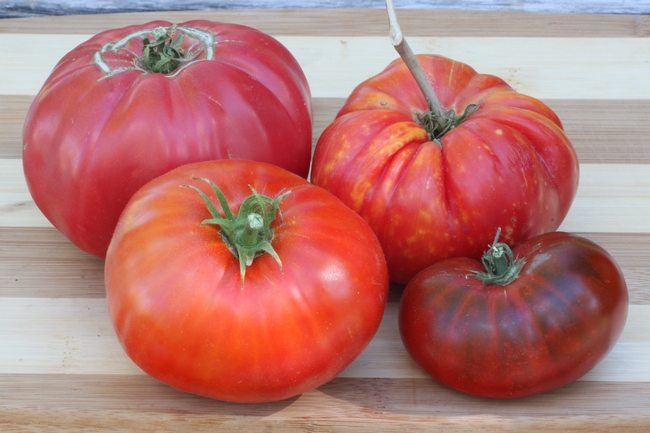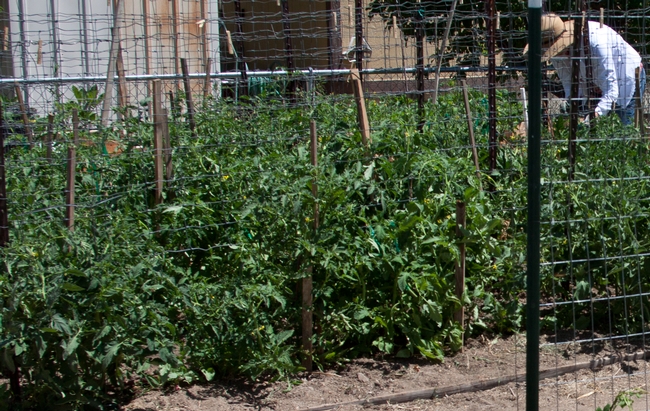- Author: Carolyn Lynch
MARCH, 2015
“Sow seeds indoors 6 to 8 weeks before the last frost date.” Uh-oh… that's NOW.
March is the month for Owens Valley growers to start seeds for tomatoes (other seeds too, but they are topics for other days). I find I'm never quite ready when March 1 rolls around. Every year, the hardest part is deciding what to grow and what to leave out. Should I devote space to a variety that last year gave me some of the best tomatoes I ever ate… all 3 of them? Or one that cranked out hundreds of tomatoes that were, well, pretty good?

Knowing we were not alone in this dilemma, several Master Gardeners conducted tomato trials at the Sunrise Research Garden in downtown Bishop from 2011 through 2014. Our goal was to identify varieties we could recommend to local gardeners as both (1) likely to succeed and (2) worth growing. We also wanted to find answers to questions like “are heirlooms really better than hybrids?”, “are hybrids really better than heirlooms?” and “should I grow an early variety or just wait two more weeks for ripe tomatoes?”
Here's a brief summary of some of our findings and recommendations.
HYBRID VS OPEN POLLINATED (sometimes called “heirlooms,” though many are new varieties): A lot of gardeners have strong opinions about the virtues of one or the other. Conventional wisdom, in a nutshell, finds that hybrids are more reliable, and open-pollinated tomatoes taste better. At Sunrise, we found truth in this assessment… sometimes.
The first few years, our hybrids didn't perform significantly better than the open-pollinated (OP) varieties we grew. In each category we had some winners and some duds. This changed when our soil became infested with root-knot nematodes. In our fourth year, almost across the board, our nematode-resistant hybrids succeeded and our OPs failed. It seems reasonable to conclude that where there's a known disease or pest issue in a garden, a grower is much more likely to succeed with plants with known resistance to that disease or pest. While there are a few OPs (for example, Rutgers) with demonstrated resistance to one or more diseases, most resistant varieties are hybrids.
On the topic of flavor… it's subjective. Several of our hybrids did very well in our yearly “taste tests,” conducted by subjective humans, and some of the OPs fared poorly. Overall, though, good OPs were more likely to thrill us with intense flavors and lush textures, while good hybrids often tasted more juicy, fresh and bright. Our all-time taste test winner? A hybrid: Sun Gold.
One big advantage of OP tomatoes is that you can save their seed and grow them again. Hybrid seed will grow, but the tomatoes won't be like the ones the seed came from.
EARLY AND HEAT TOLERANT VARIETIES: Owens Valley has great tomato-growing weather but a relatively short growing season. Also, it sometimes gets really hot. We avoided growing tomatoes with days from transplant to harvest greater than 80. (Days to harvest is a figure attached to varieties by seed producers/suppliers: a ballpark estimate useful when comparing varieties, but not a promise. We have had our first ripe fruit weeks earlier or weeks later than predicted.) We have tried numerous early (fewer than 70 days) and very early (fewer than 60 days) varieties in an effort to identify good prospects for higher-elevation gardens with their even shorter seasons. We also tried several “heat set” varieties said to be less likely to suffer from blossom drop at high temperatures.
Most of the early varieties did produce fruit earlier than the others and several heat sets produced well through some very hot weather. However, several of these varieties produced tomatoes that none of us wanted to eat. Most people probably don't have the space or the inclination to grow plants that will produce tomatoes that they won't want once the good ones start to ripen. There were a few, though, that were good enough to recommend in their own right.
RECOMMENDATIONS: These varieties grew and produced well for us and tasted good, too. They are listed in general order of fruit size and earliness. HY=hybrid, OP=open-pollinated. Numbers are days to harvest given by seed suppliers/our average days to harvest at Sunrise. These varied a lot from year to year. Results from one year when a June freeze made all our tomatoes ripen unusually late skewed the overall results for the varieties grown that year; these are marked*. Disease resistance codes: V=Verticillium, F=Fusarium race 1, FF=Fusarium races 1 and 2, N=nematodes, T=Tobacco mosaic virus, A=Alternaria.
Sun Gold (HY, 57/71*, VF): Absolutely great orange cherry tomato with very sweet, fruity flavor on large, productive plants. Its only fault is the fruit cracks a lot. A lot of Sun Golds don't make it out of the garden before being devoured, however. Even some of the biggest “heirloom snobs” love this one. Why would you NOT grow it? Seeds and plants are available almost everywhere.
Super Sweet 100 (HY, 65/68, VF): Popular red cherry tomato, widely available as seeds and plants. Very productive with good sweet flavor and little cracking, the best red cherry we tried.
Bloody Butcher (OP, 55/47) and Matina (OP, 58/63): Two very early, small-fruited (1-2 oz) tomatoes with better than average flavor. Bloody Butcher was earlier and more productive but Matina won the taste test between the two. If you want really early fruit that's (a little) bigger than cherry-size or if your garden is at high altitude, these are worth growing. Seeds are available in catalogs and online.
Early Girl (HY, 60/77*, VFF): This is one of the most popular tomatoes in America for good reason. Even though it has never been all that “early” for us, once it started to bear it usually didn't stop until the plant froze. It isn't labeled a heat set, but in hot weather it out-performed several that were. Every tasting panel that has tried Early Girl gave the juicy, medium size fruit high marks for delicious flavor with well-balanced sweetness and acidity. Seeds and plants are available almost everywhere.
Jetsetter (HY, 64/77*, VFFNTA): As early in our trials as Early Girl, the medium to large fruit had really good, sweet but well balanced flavor. The combination of earliness, large fruit size, good flavor and disease resistance is the best we have seen in our trials. Seed for Jetsetter is becoming hard to find, though there are still several sources, mostly online. One problem with growing hybrids is since you can't save seed, if the seed companies stop offering it, you can't grow it.
Big Beef (HY, 73/69, VFFNTA): A superior hybrid tomato with large, delicious fruit and great disease resistance; a midseason variety, it came in early for us. We grew Big Beef for the first time last year after trying the very popular Better Boy three times. Based on our experience it is hard to imagine why anyone given a choice between the two wouldn't choose Big Beef. This variety is widely available as nursery plants and seed.
Cherokee Chocolate (OP, 75/71): This is the popular heirloom Cherokee Purple with a skin color mutation. Like Cherokee Purple, the flavor was superb, very sweet but complex. The gorgeous chocolate-brown fruit were often somewhat lobed; they suffered more catfacing or blossom-end cracking than the hybrids we grew but overall quality was more than acceptable. This is the one we fought over at the tasting table. Seed is listed in a few catalogs and online; Cherokee Purple plants can often be found in nurseries.
Prudens Purple (OP, 75/81*) and Virginia Sweets (OP, 80/71): Gigantic fruit (10 to 12 oz average; routinely 2 pounds or bigger) on monster plants. Prudens Purple is an early, very good pink (not purple) beefsteak. Virginia Sweets is bright yellow marbled with red inside and out, a beautiful tomato. Both had good flavor and wonderfully sumptuous, smooth texture. Don't try these if you don't have a lot of space. Prudens Purple seed can often be found at retail outlets (I got ours at Kmart); both are available from catalogs and online.
Other worthy varieties include Park's Whopper CR Improved (HY, 65/70, VFFNT), a reliable producer of medium (not “whopper”) size fruit, crack-resistant and with good flavor, maybe not quite as good as Jetsetter. Ball's Beefsteak (HY, 76/70, VFFT) wasn't really a beefsteak but a meaty, medium to large, round tomato with very good, full-bodied flavor. It was very productive one year but a flop the next. Some OP varieties we liked but that had issues include Gregori's Altai (OP, 67/66), a very early, tasty pink beefsteak and the similar German Johnson (OP, 80/66) which was just as early for us. Both produced fairly well but the fruit were often misshapen or ripened unevenly. One of our favorites was Sioux (OP, 70/73), a delicious medium size tomato with good heat tolerance; but we found that our Sioux seed gave inconsistent results with several plants producing fruit with very different shapes, color, and (inferior) flavor. Arkansas Traveler (OP, 85/64) is a heat set variety that gave beautiful, flawless pink fruit all season without a break; but unlike the others listed here, it didn't taste very good.
A couple of notable disappointments were the aforementioned Better Boy and Celebrity, two widely grown hybrids that didn't impress us in several tries. Most of the very early varieties we tried left us cold, including the widely praised Stupice, Sasha's Altai and Galina's.
IN CONCLUSION: Our premise has been that if a tomato does well at Sunrise, it will do well in Owens Valley. The Sunrise garden is a lot like a home garden; we try things (shade cloth, different ways to support our plants) that home gardeners might try, nothing too fancy, because we're looking for the kind of results a home gardener would get.
I know that a bad result at Sunrise is no guarantee the same variety won't succeed in another garden nearby. Celebrity has always done well for me. And Master Gardeners who have grown some of our recommended varieties at home have reported less than stellar results. But if you're trying to decide what to grow, you could do worse than to try some of the tomatoes recommended here. I have most of them growing in my kitchen right now.



